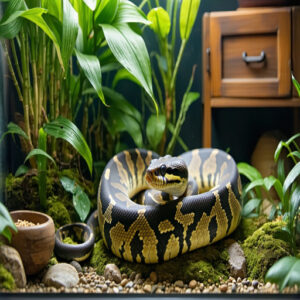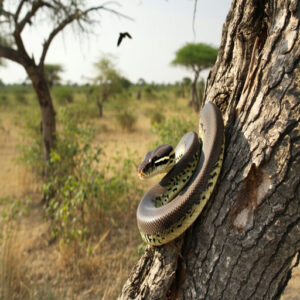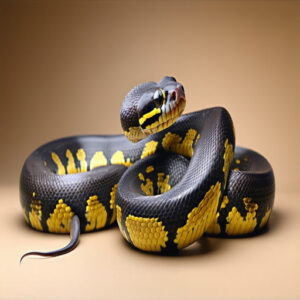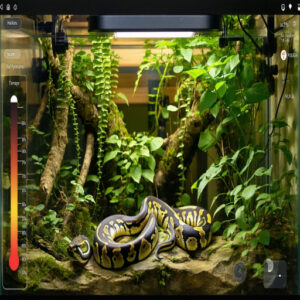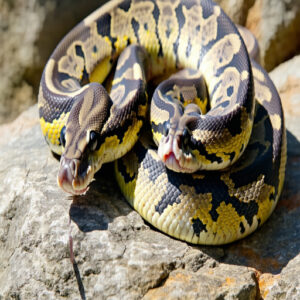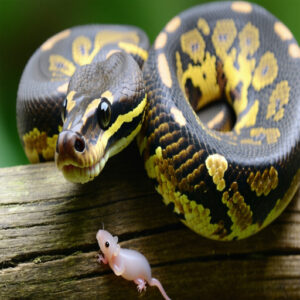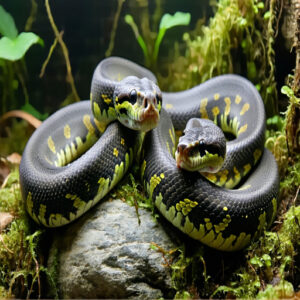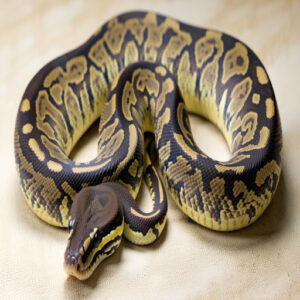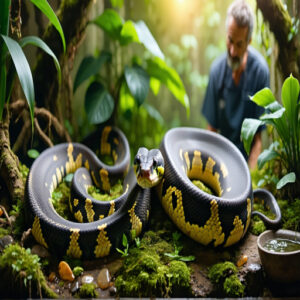This site is supported by our readers. We may earn a commission, at no cost to you, if you purchase through links.
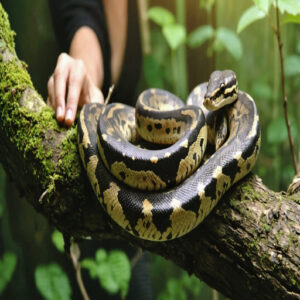
Their lifespan hinges on good genetics, a well-maintained enclosure, a healthy diet, and minimizing stress.
Think of them as long-term companions—like a loyal pet, just scalier.
Wild ball pythons don’t fare as well, surviving only 10-15 years due to predators and harsher conditions.
A cozy habitat with the right temperature, humidity, and hiding spots is key to their longevity.
Want yours to join the “30-plus club”?
Stay tuned for tips on keeping your ball python thriving for decades!
Table Of Contents
- Key Takeaways
- Average Lifespan in Captivity
- Factors Affecting Lifespan
- Habitat and Natural Lifespan
- Oldest Known Ball Python
- Captive Care and Longevity
- Signs of Aging in Ball Pythons
- Maintaining Health in Older Ball Pythons
- Comparing Ball Python Lifespan to Other Snakes
- Frequently Asked Questions (FAQs)
- What factors affect the lifespan of a ball python?
- How long do ball pythons typically live?
- How can you tell if a ball python is dying?
- What is the longest a ball python has lived?
- How long do ball pythons live as pets?
- How old is the oldest ball python?
- How aggressive are ball pythons?
- Do ball pythons like being held?
- Do ball pythons like to be held?
- Do ball python bites hurt?
- Conclusion
Key Takeaways
- Your ball python can live 20-30 years in captivity with proper care, making it a long-term commitment as a pet.
- Good genetics, a well-maintained enclosure with the right temperature and humidity, a healthy diet, and low stress are key to extending their lifespan.
- Wild ball pythons have much shorter lifespans of 10-15 years due to predators, limited resources, and harsher conditions.
- The oldest recorded ball python lived 63 years, proving exceptional care and ideal conditions can significantly boost longevity.
Average Lifespan in Captivity
You’ll find that your ball python can live between 20 to 30 years in captivity with proper care and attention.
In fact, the oldest recorded ball python reached an impressive 63 years old, so you might be sharing your home with your scaly friend for quite a while.
Typical Lifespan of 20-30 Years
Your ball python’s average lifespan typically reaches 20-30 years in captivity, making these remarkable reptiles a long-term commitment in pet ownership.
With proper reptile care, they outlive their wild counterparts thanks to:
- Controlled Environment: Perfect temperature and humidity levels boost snake longevity
- Healthcare Access: Regular vet visits prevent common health issues
- Protected Living: No predators or harsh weather affecting survival rates
Understanding ball python care is essential for maximizing their lifespan.
The aging process slows considerably under ideal care conditions.
Record Lifespan of 48 Years
Breaking all python snake lifespan records, the oldest documented ball python reached an impressive 48 years in captivity.
This remarkable maximum age doubled the typical 20-30 year average, thanks to ideal longevity factors like genetics and careful elderly care.
The aging process in these extraordinary cases shows that with dedicated husbandry and regular health monitoring, these fascinating reptiles can become truly lifelong companions.
For more information on snake longevity, it’s clear that ball pythons can live longer lives with proper care and attention to their specific needs.
Factors Affecting Lifespan
You’ll find that your ball python’s lifespan depends on several key factors, including proper housing, nutrition, genetics, and stress management.
While genetics play their part, you can substantially influence your snake’s longevity through consistent care and attention to their living conditions.
Proper Care and Housing
Smart ball python habitat setup plays a major role in reaching that impressive 20-30 year lifespan. A well-designed enclosure creates an environment where these snakes really thrive.
For ideal results, consider investing in quality ball python enclosures that cater to specific snake needs.
- Create a temperature gradient from 75°F to 95°F using reliable heating elements
- Keep humidity steady at 50-60% with proper substrate options like coconut husk
- Set up multiple snug hiding spots for security and stress reduction
- Maintain pristine water quality with daily checks
- Install climbing branches at safe distances from heat sources
Diet and Nutrition
Your ball python diet starts with the right prey size – match it to your snake’s widest body section.
Young snakes need meals every 5-7 days, while adults thrive on a meal frequency of 10-21 days.
Keep water quality high with daily changes, and verify proper nutrient intake by offering frozen-thawed prey from reliable sources.
For breeding females, calcium supplements support healthy reproduction.
Genetics
Genetic traits shape the destiny of ball pythons like a master artist’s palette.
Understanding inheritance patterns reveals five key factors affecting lifespan:
- DNA testing confirms hereditary factors
- Breed selection impacts overall health
- Genetic disorders may affect certain morphs
- Co-dominant traits influence healthiness
- Selective breeding can enhance longevity
Captive breeding programs focus on producing healthy specimens while maintaining diverse genetic pools for ideal ball python lifespans.
Stress Levels
Stress impacts ball python health and ball python lifespan more than you might think.
Environmental stress, like poor humidity control or thermal stress, can lead to snake anxiety and shorter python life span average.
Stick to gentle handling techniques, provide hiding spots, and keep their environment stable. A well-loved, stress-free snake is a healthier, longer-living snake.
Diseases and Injuries
Diseases and injuries can sneak up on your ball python, cutting its lifespan short if ignored.
Stay alert for respiratory issues, scale rot, or signs of parasite infection.
Protect your snake’s health with:
- Routine vet visits for infection management and parasite control.
- Clean enclosures to prevent snake health problems like wound infections.
- Safe setups to avoid burns or injuries, aiding wound healing.
Habitat and Natural Lifespan
Ball pythons are native to the grasslands and forests of West and Central Africa, where their lifespan typically ranges from 10 to 15 years.
Wild conditions like predators and limited resources mean they generally don’t live as long as their captive counterparts.
Native to West and Central Africa
Ball pythons come from the sunny savannahs and wooded areas of West and Central Africa, thriving where warmth and humidity meet.
Stretching from Senegal to Uganda, they live quietly, blending into the African habitat.
These shy snakes adapt to the desert ecosystem’s rhythms, hunting wild prey like rodents at night.
Unfortunately, their natural homes face threats like deforestation and the pet trade.
Still, their migration into captivity has helped prolong the average ball python lifespan considerably.
Lifespan of 10-15 Years in The Wild
Out in the wild, the average lifespan of a ball python is much shorter—typically 10 to 15 years—due to predators, habitat loss, and food scarcity.
Unlike the controlled conditions of captivity, their survival depends heavily on the African ecosystem, where challenges like human activity and unpredictable environments test their resilience.
Wildlife conservation efforts help protect their natural habitats and snake longevity.
Oldest Known Ball Python
The oldest known ball python defied expectations, living an incredible 48 years in captivity—a true indicator of how good care can stretch the limits of python longevity.
While most of these snakes settle for around 20–30 years in captivity, hitting nearly five decades is a record worth noting.
So, what makes this possible? Understanding the ball python age factors can substantially influence the snake’s overall health and lifespan.
- Top-tier husbandry: Balanced temperatures, proper humidity, and space to move.
- Stress-free care: Avoid overcrowding and sudden environmental changes.
- Veterinary insights: Identifying and addressing health issues early.
- Python genetics: A lucky roll of the biological dice helps.
Knowing this, you’d agree the aging process for pythons thrives under quality care, a reminder that their average ball python lifespan is just the beginning.
Captive Care and Longevity
To keep your ball python healthy and guarantee it lives a long life, focus on providing the right environment and a proper diet.
Consistent attention to temperature, humidity, enclosure size, and feeding habits can make all the difference in their lifespan.
Importance of Temperature, Humidity, and Enclosure Size
A good ball python habitat setup hinges on precise thermal gradients (75-95°F) and humidity control (50-60%).
Include hides for comfort, fresh water, and a solid enclosure design to encourage natural behaviors.
Simple touches like climbing branches mimic their wild homes.
Maintaining the right humidity levels is essential for preventing dehydration and skin issues in ball pythons.
Get these details right, and you’ll boost their health, happiness, and overall ball python lifespan in captivity.
Proper Feeding Schedule and Prey Size
Getting your ball python’s meals right helps them stay healthy and active.
Stick to a snake feeding schedule: juveniles eat every 5-7 days, adults every 10-14.
Use this python feeding guide—prey about 10-15% of their weight works best.
Opt for quality frozen or live mice/rats.
Proper feeding techniques and prey selection keep their growth, digestion, and energy levels in check.
For superior nutrition, consider Ball python food options that cater to their specific dietary needs.
Signs of Aging in Ball Pythons
As your ball python ages, you might notice subtle changes in its behavior and appearance.
These signs, like reduced activity or changes in appetite, can help you understand and support your snake’s health in its later years.
Slowed Metabolism
As ball pythons age, their metabolic rate naturally slows as part of the aging process.
You’ll notice reduced energy levels and longer digestion times, which are perfectly normal signs of cellular decline.
They may bask more often to regulate warmth.
- Signs of slowed metabolism:
-Reduced movement throughout the day
-Delays in digesting food
-Less active hunting posture
-Greater reliance on heat areas
-Longer recovery from meals
Decreased Appetite
Noticing changes in eating habits?
Older ball pythons may experience appetite loss due to slowed metabolism.
Watch for health issues like infections or weight loss.
Keep their diet consistent and environment ideal.
If food refusal persists, consult a vet.
| Symptom | Possible Cause | Solution | When to See a Vet |
|---|---|---|---|
| Appetite loss | Aging or stress | Adjust diet | After 2+ weeks of refusal |
| Irregular shedding | Low humidity | Increase enclosure humidity | Persistent shedding issues |
| Weight loss | Illness or injury | Regular feeding | Ongoing unexplained weight loss |
| Food refusal | Environmental changes | Check temperature | Sudden long-term refusal |
Reduced Activity Levels
Older ball pythons often display idle behavior and slow movement, embracing a more sedentary lifestyle.
These inactive periods are natural signs of aging, reflecting the typical ball python average age.
Understanding the ball python lifespan is essential for providing proper care.
To support their health, keep them active with gentle handling or supervised exploration. Reduced energy shouldn’t always alarm you—it’s part of the snake’s journey within their impressive ball python lifespan.
Skin Changes
As your ball python ages, its skin undergoes subtle changes, signaling the natural progression of its lifespan.
Shedding may slow, patterns can fade, and scales might develop a rougher texture.
- Key changes to watch:
-Thicker necks and noticeable head enlargement.
-Muscle loss making tails appear shorter.
-Color fading or minor pattern adjustments.
Be vigilant for signs of skin lesions or scale rot, ensuring proper python snake care.
Maintaining Health in Older Ball Pythons
Caring for an aging ball python means paying closer attention to their changing needs.
With small adjustments to their diet, habitat, and routine check-ups, you can help them stay healthy and comfortable in their golden years.
Regular Veterinary Check-ups
Routine veterinary care is key to extending your ball python’s lifespan.
Regular medical checks can catch issues early, like infections or parasites, before they shorten your snake’s life.
Genetic screenings during visits offer insights into potential health risks.
While vet costs might add up, investing in pet insurance keeps expenses manageable, ensuring your python stays healthy and thriving for years to come.
Considering pet insurance plans can be a significant step in maintaining your ball python’s overall health and well-being.
Adjusting Diet and Housing as Needed
Older ball pythons thrive with smaller, well-spaced meals matching their slower metabolism.
They require prey sizes that suit their reduced appetite—overfeeding shortens the python average lifespan.
Keep the enclosure cozy with stable temperatures and humidity; stress from poor housing options harms longevity.
Regular cleaning prevents illness, ensuring the ball python maintenance routine supports its lifespan of python inhabitant through every stage of aging.
Providing Enrichment and Exercise
Keep your ball python active with animal enrichment and playful exercise routines.
Add climbing branches, cork hides, or environmental toys to their enclosure for exploration and sensory stimulation.
Try a snake-safe "jungle gym" for snake agility or supervised outdoor time.
Habitat variety keeps things fresh, while reptile enrichment like scattered scents engages their natural instincts.
Happy snakes live longer!
Comparing Ball Python Lifespan to Other Snakes
When comparing ball python lifespans to other snakes, you’ll notice they live on the longer side, often reaching 20-30 years in captivity.
Corn snakes, kingsnakes, and boa constrictors can live similarly long lives, with some variation depending on species and care.
Corn Snakes: 15-20 Years
Corn snakes live 15-20 years in captivity, slightly shorter than the ball python lifespan.
They thrive with proper Corn Care, including a varied Reptile Diet of mice and small birds.
Their smaller Snake Habitat makes them easier to manage, and they’re more tolerant of handling.
These wild snakes turned pets offer a manageable and rewarding experience, with a strong focus on Pet Longevity.
Kingsnakes: 20-30 Years
Kingsnakes can rival the ball python lifespan, living 20-30 years with proper care.
Their longevity depends on a few key factors: diet, including appropriately sized prey, and a well-maintained enclosure offering the right temperature and hiding spots.
Wild kingsnakes face shorter lifespans due to predators and habitat challenges, but in captivity, reptile care makes all the difference.
Enrichment, like climbing branches, keeps pet kingsnakes active and thriving alongside their python counterparts.
Boa Constrictors: 20-30 Years
Boa constrictors, like ball pythons, enjoy a lifespan of 20-30 years with proper care.
Their diet and habitat, just like the ball python life cycle, play pivotal roles in their longevity.
With thoughtful Boa care and attention to reptile health, these pets thrive for decades, as these giants can grow up to 13 feet, making spacious enclosures essential for their health.
Frequently Asked Questions (FAQs)
What factors affect the lifespan of a ball python?
A ball python’s lifespan depends on diet, habitat, and health.
Keeping the right temperature, humidity, and a clean enclosure is key.
Genetics also play a role, along with regular vet visits to catch issues early.
How long do ball pythons typically live?
Ball pythons typically live 20 to 30 years in captivity with proper care.
In rare cases, they can reach their 40s.
Wild ball pythons have shorter lifespans, around 10 years, due to predators and harsher conditions.
How can you tell if a ball python is dying?
When the light fades from their eyes, and movements slow to a crawl, watch for lethargy, refusal to eat, rapid breathing, or a sunken body.
These signs could mean your snake’s health is failing.
What is the longest a ball python has lived?
The longest a ball python has lived was estimated at 63 years old as of
That’s an impressive lifespan, proving they can thrive incredibly well in captivity with proper care and attention.
How long do ball pythons live as pets?
Think of ball pythons as the marathoners of the snake world—these pets can live 20-30 years with proper care.
Give them the right diet, habitat, and attention, and they’ll stick around for decades!
How old is the oldest ball python?
As of 2021, the oldest ball python recorded was 63 years old.
This snake, living at the Saint Louis Zoo, demonstrates just how impressively long these pythons can thrive with proper care and conditions.
How aggressive are ball pythons?
Calm, quiet, and shy—that’s a ball python for you.
They’re rarely show aggression, they’re more likely to curl into a ball than bite.
Handle them gently, and you’ll gain their trust over time.
Do ball pythons like being held?
Ball pythons tolerate handling rather well but don’t seek it out.
Their calm nature makes them easy to hold, though over-handling can stress them.
Stick to short handling sessions to keep your python comfortable.
Do ball pythons like to be held?
Imagine this scenario: your ball python sees you as a warm branch rather than a buddy.
They tolerate handling if gentle and consistent, but they don’t crave it—think of them as introverts with scales.
Do ball python bites hurt?
A ball python bite doesn’t typically hurt much—it feels like tiny pinpricks.
Their teeth are small and not designed to wound, so you’ll feel more surprise than pain.
It’s rarely a serious issue.
Conclusion
Caring for a ball python is more than a hobby; it’s a long-term partnership.
With a lifespan of 20-30 years, and the potential to surpass even that, these snakes thrive with proper care.
Providing the right environment, a balanced diet, and keeping stress low guarantees your ball python stays healthy and happy.
While genetics play a role, your effort substantially affects their lifespan.
Commit to their needs, and your ball python could become a record-breaking example of longevity.
- https://reptilinks.com/blogs/news/should-i-get-a-ball-python-as-a-pet
- https://www.inaturalist.org/guide_taxa/257679
- https://www.reddit.com/r/ballpython/comments/erygm4/fun_fact_when_taken_care_of_properly_ballies_can/
- https://www.riverviewparkandzoo.ca/en/zoo/ball-python.aspx
- https://www.petmd.com/reptile/ball-python-care-sheet


